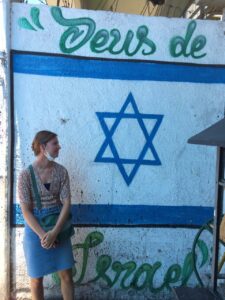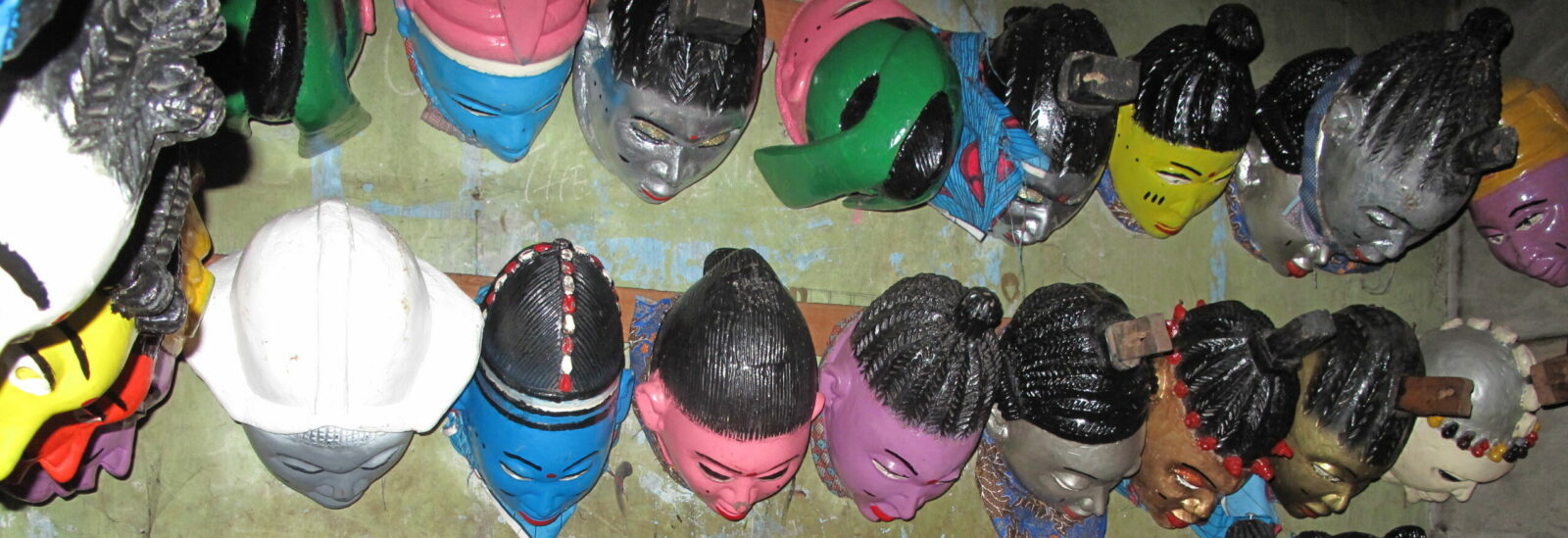Blog
Field Impressions
By Andy Fuller and Jolien van Veen
The Pandemic has disrupted one of the vital features of anthropological work: the very act of being there, being in amongst the circumstances one analyses describes and explores. Being there, over a period of time, facilitates insights and shifts in questions; it shapes narratives, terminology and creates access to unexpected informants. The fieldwork, the location, the site, also plays the often somewhat dislocated researcher who finds him or herself in amongst new communities and social circumstances. And, arguably, ethnography becomes a mutually creative act; between the researcher and informant and the resulting work is some kind of negotiation of questions, observations, sensory experiences and storytelling.
This is hopefully one of several interviews with SACRASEC members about their fieldwork experiences. Jolien, who had to go through a multi-layered bureaucratic process to finally get to Rio, generously shares her experiences and observations in the text below. The text originated from an email exchange between the authors, over the months February-March 2022.

One of the murals marking the Complexo de Israel. Photograph property of Jolien van Veen.
What were your first impressions upon starting your fieldwork in Rio?
I left the Netherlands in November 2021, at the start of winter and right before the Dutch government announced a third lockdown due to the increasing number of Covid-19 infections. When I arrived in Rio, there were only a few cases of Covid-19 infections in the city. Bars, shops, and restaurants were all filled with people kicking off the summer holidays. So, initially it was a bit of a shock just to be able to walk outside in a t-shirt and go for a drink with people in a bar.
Although this is my first time in Brazil, one of the first thoughts I had was how much it resembled Medellín, Colombia, where I had previously conducted fieldwork. On the way from the airport to my homestay, a 35 minute drive, we passed rows and rows of red brick one- and two-story houses amongst steep hills. These informal settlements, known as favelas or comunidades, are often portrayed in news media and popular culture as the locus of violence and poverty[1]. I asked my taxi driver whether she knew the name of the community we were passing by as we moved south along the Avenida Brasil. “This one is called Maré, it’s very dangerous” she commented. “It’s a different kind of Rio, behind these hills” she said with more enthusiasm, pointing towards the luxury apartment buildings and the famous beaches of Ipanema and Copacabana that we were heading towards.
Having been here now for over three months, I noticed that the Zona Norte, referring to the area along the Avenida Brasil that lies north of the city center, is very diverse. In between the favelas lie large housing complexes, big shopping malls, numerous churches and even an old palace dating back to the Portuguese kingdom in 1808. The contrast between these buildings and the more compact, upper class districts of Southern Rio points to a visible and uncomfortable reality of economic inequality and government neglect. This reality is something that I’m still trying to come to terms with.
What has the sensory experience been like? How do sensory experiences shape the way you come to know a place?

The campaign: “Vaccine in your arm, food on your plate” was organized by the labor union of the Rio de Janeiro State University as a critique on Bolsonaro’s handling of the Covid-19 health crisis. Photograph by author.
There are various sensory experiences that come forward when moving through the city. Having grown up and lived most of my life in predominantly white, upper middle class neighborhoods in small cities, I was unaccustomed to many of the smells and sounds that characterize a megacity like Rio de Janeiro. I noticed in particular the strong smell of urine and exhaust fumes on the street, the many homeless people, the loud traffic noises, the smells of grilled meat and fish sold by street vendors, the sounds of samba, MPB[2] or carioca funk[3], and the sounds of police helicopters flying overhead. At the height of summer, I noticed the contrast between the cool airconditioned rooms of office buildings and the humid, hot air in the streets. The pandemic has also made me more attentive to the chemical smell of hand sanitizer and the somewhat clumsy act of constantly putting on and removing my face mask when going out (from March 7th, face masks are no long mandatory in closed spaces yet many people continue to wear them).
Some neighborhoods look, sound, smell, and feel more familiar than others. Ipanema, which is generally considered a wealthy neighborhood with chique bars and tree-lined streets, has a very different ambience from the city center, with its dated buildings, graffiti and street vendors selling all sorts of food, clothing, and household products. One interlocutor told me that he found the city center to be the most atmospheric neighborhood of Rio, with a rich history of music and dance bars, but that most foreigners whom he works with as a dance teacher feel uncomfortable at the sight of the small, narrow alleys that surround the center.
I think this discomfort also ties into questions of how people understand safety differently: for people who frequent middle and lower-class neighborhoods “danger” looks differently than it does for people who reside mostly in the upper-class neighborhoods. To give an example: the sight of a police car, and the presence of police officers at street corners to me signified that there was some sort of control, of protection, at these sites. But various Brazilian informants have told me that the police, in fact, makes them feel more unsafe.
What are the traces of security throughout the city?
Security, or rather the concern with being “safe” is omnipresent. The most explicit examples of this, alongside daily news reports on crime and murders, are the various police cars located at key roads or tourist attractions in the city. There are also often police helicopters flying over the city and over the beaches, which my partner commented “makes it look like the opening scene of Apocalypse Now”. From what I’ve seen on the streets, the military police wear army uniforms and carry large guns while the civil police wear black uniforms and appear more casual. There are also various people who wear blue and white vests labelled segurança presente (security present) in crowded areas such as on the beaches and in tourists spots. Their connection to the police, at least to me, is unclear.
In terms of how buildings and public spaces are constructed, most apartments in the residential neighborhoods of the southern area have an iron gate and/or a doorman. Some streets are also closed off by a barrier and one or two men who stand next to the barrier to check who enters and leaves. The apartment where I lived for six weeks had a barrier at the beginning of the street, which, according to my landlords, was to protect the people from robberies.
Security often comes up in conversations I have with others, even without directly asking about it. Taxi drivers are especially curious to hear whether I think Rio is “safe” and are quick to give advice on where (not) to go. In conversations with my landlords, whenever I bring up the topic of my research and the fact that I want to do fieldwork in a favela in the north of Rio, people often react surprised and ask me if I’m not afraid to go there, or they tell me to be very careful. These warnings have made me aware not just of the different experiences and ideas people have of violence, danger and crime as located in particular parts of the city, but also of the fact that others construct my position as a young, white, woman as someone who is in ‘need of protection’. For example, after a night out two male friends insisted on walking me to my apartment, which was located only a couple of blocks away. They jokingly told me that they would act as my ‘personal security guards’, but then, in a more serious tone, told me that it was better to avoid walking around alone at night.
How have you found the initial stages of your fieldwork?
I have learned over these first few months that it is important to be patient. I am having many moments when I feel like I am not doing enough, while on other days I feel overwhelmed by the conversations I have with people and the information I obtain through these conversations. Especially in the first four weeks, I felt quite nervous about meeting people and going on field trips. Part of this nervousness came from spending so much time preparing for the fieldwork in the Netherlands and not wanting to ‘waste’ my time in Brazil sitting behind my laptop trying to contact people. I am still trying to find a rhythm, or a balance between going on field trips, organizing interviews, and taking notes.
Another reason why I felt nervous is because I felt like I could not make a clear judgement as to whether the places that I want to visit (religious sites in the suburbs) are safe or not, because of the mixed reactions I get from local residents. For example: I contacted two people who had both worked together with a Dutch researcher in the past. Both of them are male and both of them have lived in the same favela in the North zone. One of the men told me he would be happy to talk to me, while the other guy messaged me saying that “the community is very dangerous, I don’t recommend you go there. I myself do not live there [anymore]”. So my feelings constantly switched between not wanting to lose time, and not wanting to rush into anything or be naïve about the risks involved in doing this kind of fieldwork.
Have your research questions been changing since you arrived in Rio?
My initial research question revolved around the different expressions of power and authority by non-state armed groups and their connection to religious institutions, symbols, images, and sounds. I chose to focus on a group of favelas known as the Israel Complex, located in the North zone of the city, as my field site. This location is particularly interesting because of the ongoing disputes between armed groups and because of the strong presence of Evangelical churches in the area. However, it has been challenging to establish relationships with people who can accompany me to churches located inside the favelas. So I have mainly frequented churches and sites of worship located on the borders of the Complexo, which are also interesting sites from which to explore the various forms of authority and control exercised by non-state armed groups[4]. In conversation with the leaders of these religious sites, and by participating in the social projects they organize, new questions have come up. For example: How do different religious leaders (Catholic, Evangelical, and Afro-Brazilian) react to the formation of the Israel Complex? Which kind of negotiations are taking place between these leaders and non-state armed actors operating in the area? Do religious leaders differentiate between the authority of the comando and the militia? And who is responsible for taking care of the community, and for protecting people, in the suburban neighbourhoods of Rio de Janeiro? I am confident that further involving myself in various churches, attending services and participating in social projects, will enable me to answer these questions. I am also planning to continue my informal conversations with other residents and to reflect on my own thoughts and experiences when moving around the area. Finally, I am paying attention to the visible and audible ways in which religious and non-state armed groups are present in the area.
[1] See, for example, the movie directed by Fernando Meirelles and Kátia Lund: Cidade de Deus.
[2] MPB – Música Popular Brasileira is a collective term for music styles that mix classic and modern influences, such as those originating from bossa nova or samba as well as pop and rock.
[3] Carioca funk is an electronic music style that originated in the favelas of Rio de Janeiro. It is characterized by a loud bass and rap-style lyrics.
[4] It is important to note that Rio de Janeiro is divided amongst several factions, or comandos, who control the favelas: the Red Command, the Pure Third Command, and the Friends of Friends. Alongside these, paramilitary groups known as milícias control large parts of the suburban neighborhoods.

